|
|
|
Facilitated Table Discussions
Purpose
During the Facilitated Table Discussions, attendees were asked to process all of the information received over the previous two days and develop actionable solutions. The goal of the Facilitated Table Discussions was to gather feedback from the various attendees to be utilized in the creation of a Workforce Development Plan.
Process
During the group discussions, attendees were divided into 14 groups. Each group had a person transcribe the group’s answers to the questions. Once the question was presented, each group was allocated 15 minutes to develop answers. When the discussion was completed, a representative delivered the solutions to a Chamber representative. After all of the solutions were collected, they were delivered to the LSINC Strategy Team to be analyzed and categorized for the creation of the survey.
The following questions were presented to the groups:
Observations
The following section offers a high level analysis of the answers provided during the Facilitated Table Discussion. Word clouds are used to provide a visual depiction of the top 25 substantive words found in groups’ answers. The size of the word indicates the words frequency. The larger the word, the more frequent the word appears in the groups’ suggestions. Color has no significant meaning. |
|
Question #1 – What are our industry/occupation focus areas?
The first question of the Functional Table Discussions asked the groups to determine industry and occupation focus areas. Figure 3-1 gives a visual representation of the top 25 most common substantive words used in the answer sheets submitted by the 14 groups. Manufacturing (including Advanced Manufacturing) was a one of the top focus areas. Another major area of focus was education. The words schools, students, education, and colleges were frequent amongst the groups’ responses. Healthcare and Cyber were also listed as area of interest.
Manufacturing was a recurring topic among the presentations and best practices given during the Summit. Region 2 has been primarily known for engineering and science. The respondents identified that in order for the area to continue to grow, the workforce portfolio must be diversified. The groups agreed that bringing commercial manufacturing to the region will allow for more jobs to be created and will make the area less reliant on federal spending. In order to facilitate this change, the group recognized that the approach to education must be modified. The responses reflected the focus on education and skills training during the presentations. Additionally, the groups identified that students need to understand that there are great jobs and career paths available through obtaining a technical degree and that technical degrees and specialized training are key to addressing the skills gap already present in the region.
Though STEM was selected as the main area of focus in the survey (see Survey Figure 4-1), it was not the most provided answer in the Facilitated Table Discussions. Engineering, Business, and Management made the topic 25 suggestions, but were behind Manufacturing and Education.
Figure 3-1: Top 25 Substantive Words in Facilitated Table Discussions Question #1. |
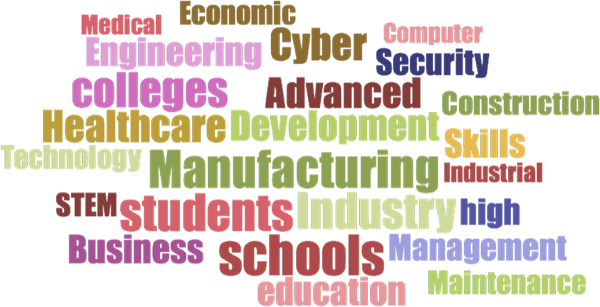 |
|
Question #2 – What organizations need to be involved? Who should take the lead?
There were numerous suggestions in regard to “What organizations need to be involved?”. Ten out of the fourteen groups suggested the Chamber of Commerce be involved. Other prevalent organizations include various institutions within the education systems ranging from K-12 to two and four year colleges. Business and industry were also common suggestions among the groups. These results mirror the results given in the survey, which can be found in Section 4. The word development is also prominent as seen in the word cloud, Figure 3-2. These suggestions included the workforce development organizations and leaders as well as economic development organizations and leaders.
Response Highlight
“Create a new organization led by the local Chambers to coordinate and develop a pipeline strategy between K-12, Higher education and Industry. Such a convening organization could be similar to the Boston Private Industrial Council.”
Figure 3-2: Top 25 Substantive Words in Facilitated Table Discussions Question #2 – What organizations should be involved? |
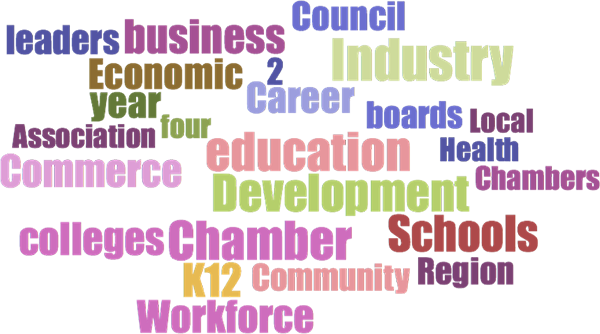 |
The second half of question two involved the groups deciding who should lead this initiative. The results of the group discussion for this part of the question were similar to the results of the survey. Industry, the Chamber of Commerce, the Regional Workforce Council, and K-12 were suggested as potential leading organizations. Despite only appearing once among the group suggestions, the Regional Workforce Council tied for the top rank in the survey. However, there was not a drastic difference in the rankings of the lead organizations in the survey.
Response Highlights:
“Lead should be taken by:
- Chamber – More global perspective/facilitator
- Industry needs to share where there is a need
- Schools Foundation
- Public Education “all education is career education.” Each district has individual need/voice; ex. State of AL and Mobile County schools; Workforce Development Director at each district and in some cases this may align with career and tech.”
|
|
Question #3 – How do we measure success? How do we incentivize success?
Questions #3 was a two part question asking the groups to give suggestions on how to measure and incentivize success. Figure 3-3 contains the top 25 substantive words found within the groups’ submitted suggestions. The most prominent word is “increase”. Many groups felt success could be measured by an increase in jobs, job placement, opportunities, enrollment in education, and graduation rates. “Education” was also prevalent throughout the suggestions. This includes students being college ready and having the ability to obtain a job after graduation. Lowering “unemployment” “rates” and “underemployment” “rates” are also top suggestions.
While many groups suggested specific statistics to be measured, there were also suggestions for processes to be developed to effectively measure success. This included establishing a baseline by which to measure success and establishing rubrics for each organization to follow. Other suggestions involved tracking the success of employees and students and soliciting feedback from involved organizations.
The suggestions on how to measure success reflect the presentations given during the Summit. Strategically ensuring continued growth and prosperity within Region 2 would involve educating the workforce in the skills needed be successful in the new, changing work environment. It was identified that this success begins with education at the most basic level. Groups mentioned increasing graduation rates of K-12 alongside post secondary education as a measurement of success. An increase in graduation rates will increase the likelihood a student will be able to find a skill labor job after graduation. Emphasizing the importance of completing technical degrees and certifications was viewed as a way ensure manufacturing skill gaps are being filled. It was also suggested that success could be measured through the amount industry provided internships, apprenticeships, and co-ops. Early successes in this area should lead to success in industry and ultimately a thriving workforce.
Figure 3-3: Top 25 Substantive Words in Facilitated Table Discussions answers to Question #3 – How do we measure success?
|
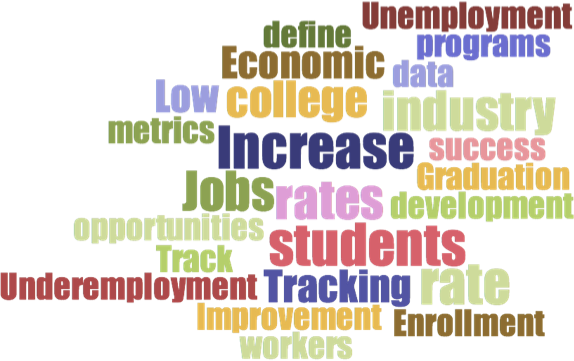 |
A wide variety of suggestions were given in regard to “How do we incentivize success?”. As seen in Figure 3-4, many of the words are smaller indicating less frequency within the suggestions as well as less consensus among the groups. An overarching theme within the responses was “education”. Words that were common among the groups included “students”, “jobs”, “reward”, “industry”, and “performance”. The groups felt educational institutions should be rewarded for good performance. Industry should establish sponsored co-ops for students. The solutions around the word “job” included pay and benefits, job satisfaction, and training.
Suggestion Highlights
“Saying less of: if only…wish I could…what if…Highlighting more: now we can…moving forward…OK, lets…”
“Flexibility within education system so students can participate in apprenticeship and still be involved in extra curricular activities”
Figure 3-4: Top 25 Substantive Words in Facilitated Table Discussions answers to Question #3 – How do we incentivize success? |
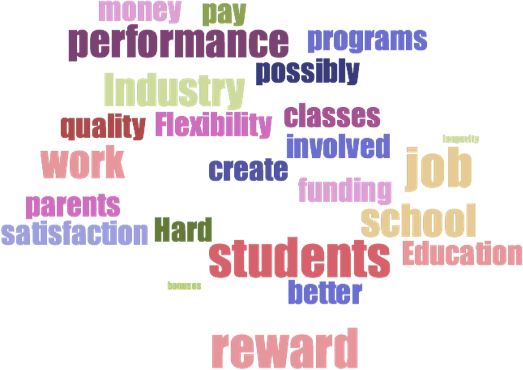 |
|
Question #4 – How should this effort be funded?
There are reoccurring suggestions among the groups in regard to funding suggestions. “Industry” was the most prominent suggestion as a funding source. This suggestion was corroborated by the survey results found in Section 4. Another prominent word depicted in Figure 3-5 is “education”. However, there was not a consensus of groups suggesting “education” should fund the initiative. An “education lottery” was mention as well as establishing a Workforce & Education Development Growth Initiative (WEDGI). Group 8 passionately stated, “Legislation needs to leave education funding alone! That is all…”
Other prominent funding suggestions included “taxes” and “lottery”. Despite being common within the group discussions, a “lottery” was not a popular funding suggestion when viewed in the survey results. Conversely, “taxes” was a popular suggestion in both the Facilitated Table Discussions and the survey.
Figure 3-5: Top 25 Substantive Words in Facilitated Table Discussions answers to Question #4 – How should this effort be funded? |
 |
|
Bonus Question – What have we not covered?
The Facilitated Table Discussion session concluded with a bonus question asking the groups to provide any suggestions for topics that were not covered during the discussion. The most frequent words, as depicted in Figure 3-6, were “education”, “community”, and “work”. “Education” was the most frequent, and those suggestions involved the community. An example, “How to educate the community about what you are doing so that you get community buy in. (example- opposition to common core).”
Suggestions involving “work” included changing the mindset of workplace, learning work ethic, providing a positive work environment to deter union activity, and aligning education with workforce needs. Overall, the bonus suggestions tied into the rest of the discussion and presentation in that solutions will be derived from the efforts of industry and education.
Figure 3-6: Top 25 Substantive Words in Facilitated Table Discussions answers to Question #5 – What have we not covered?
|
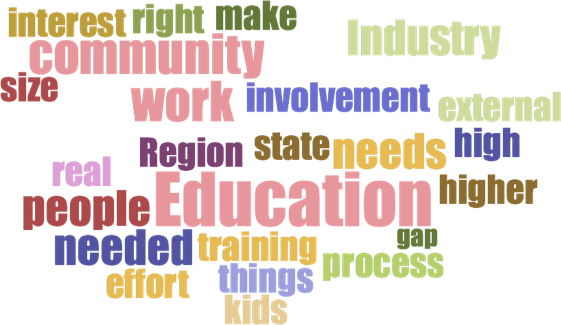
|
|
|
 |
| |
|
|